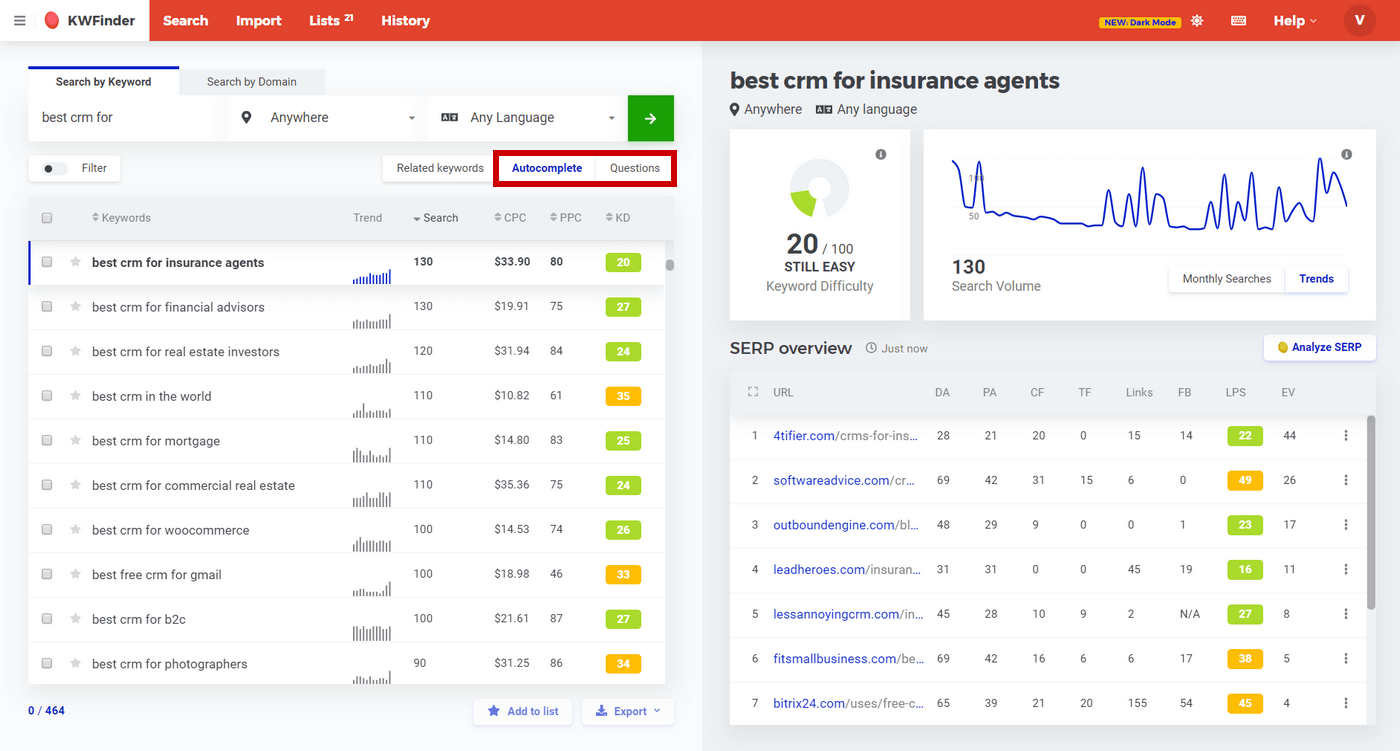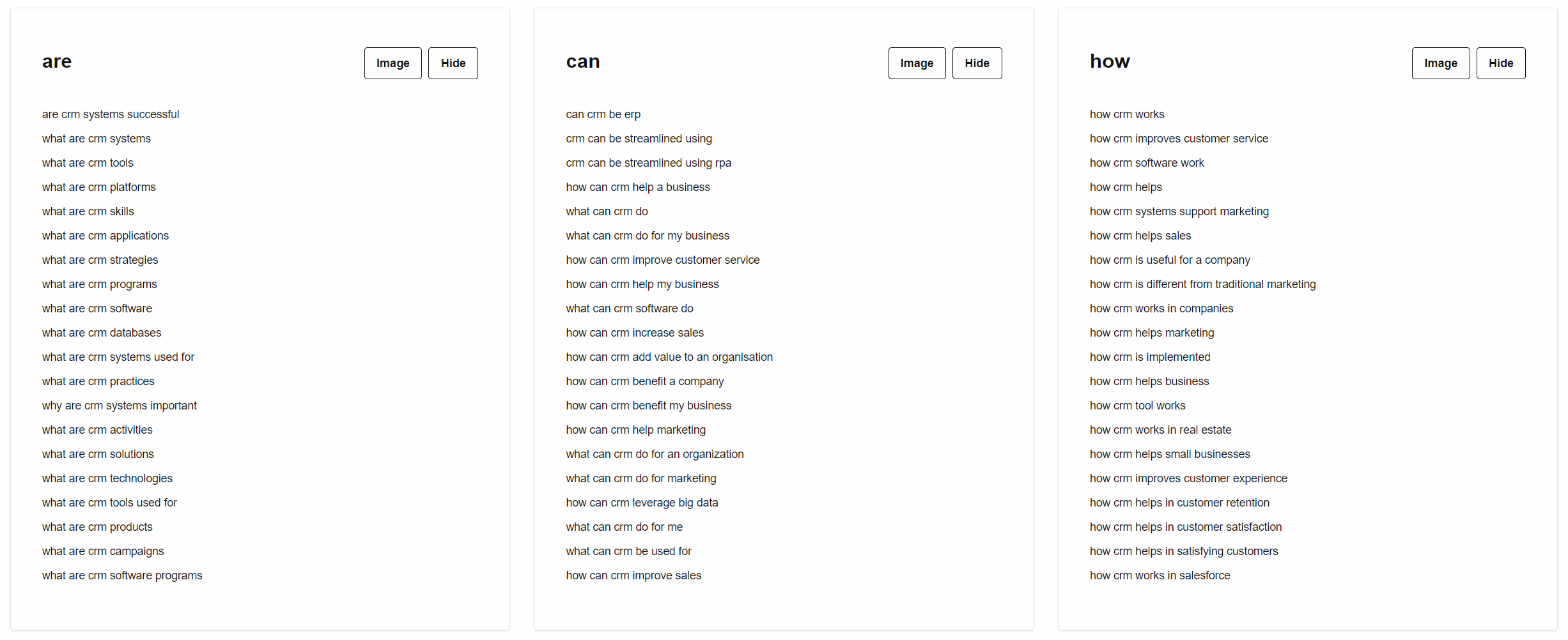Everybody wants to drive relevant visitors to their website.
One of the best ways to do it is to target long-tail keywords: specific phrases your audience is already searching for.
In this guide, we’ll take a closer look at:
- What are long-tail keywords
- Why are they important for businesses
- 5 ways to do long-tail keyword research
- What makes a “good” long-tail phrase
- How to target long-tail terms on your website
What are long-tail keywords?
Long-tail keywords are search terms that are more specific (and usually longer) than a standard search query.
They tend to have a higher conversion because the search intent is more straightforward (e.g. a user searching for “best running shoes for kids” is more likely to buy than someone searching for “shoes”).
The key characteristics of long-tail keywords:
- they consist of more words (which means they are more specific)
- they usually have lower search volume, but also lower keyword difficulty
- they tend to have higher engagement and conversion
- they are responsible for most of the organic traffic (about 70%)
People use long-tail keywords to find specific things online – like you, who likely searched “what is a long-tail keyword”, to find this post. Other examples of long-tail keywords include:
- “best charger for MacBook Pro”
- “how to change a tire”
- “women’s Nike running shoes size 12”
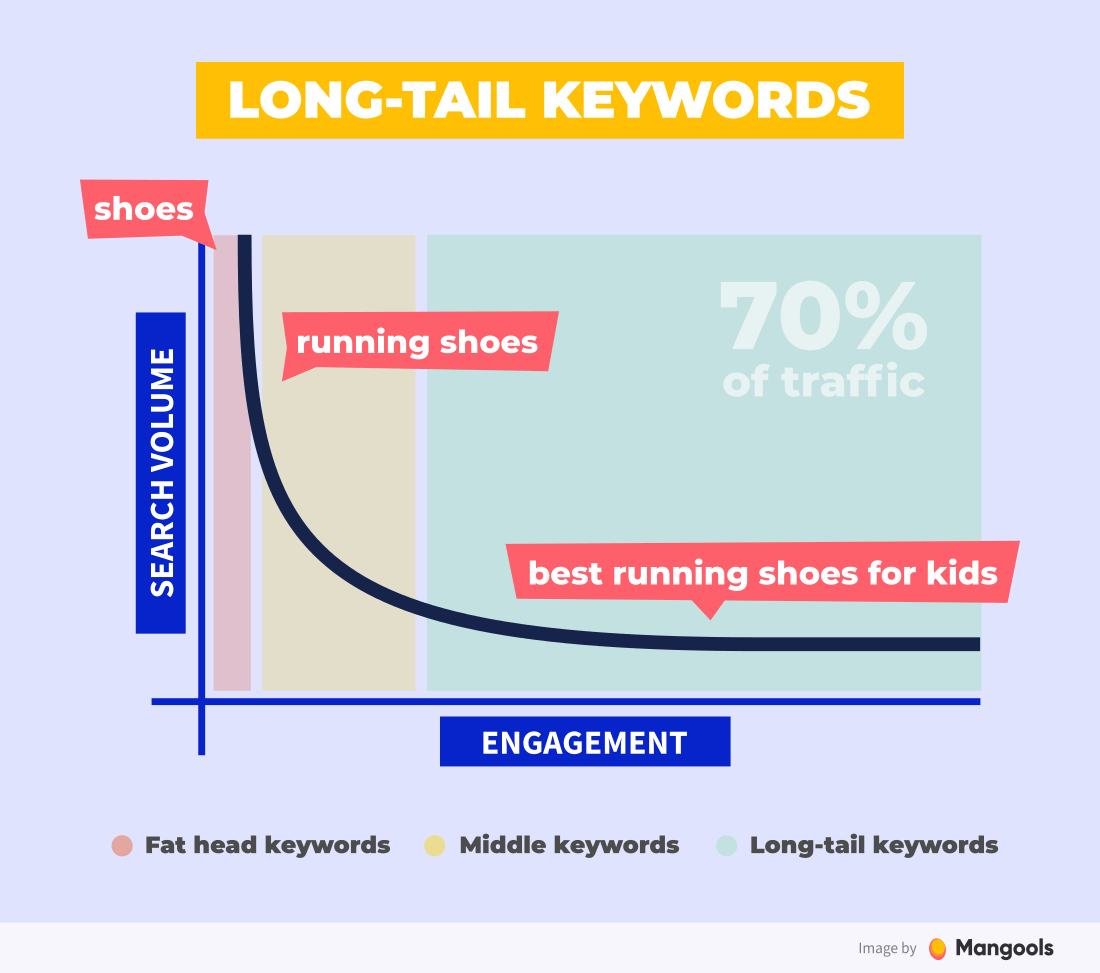
How many words does a long-tail keyword have?
Hands up if you’ve heard this phrase: A long-tail keyword means a phrase 4+ words long.
That’s not entirely accurate; a long-tail keyword just means a more specific search term than another. It doesn’t matter how many words it has.
Let’s put that into context. The phrase “men’s blue swimming cap” is more specific than “swim cap” – that’s what makes it a long-tail term. Granted, the fact it is longer in length is a common factor of a long-tail phrase, but not the defining factor.
Long-tail just means it’s more specific than a standard search term.
Tip: Don’t forget to check out our ultimate guide to keyword research where you’ll find everything about keyword research, including a ton of useful tips and a quiz!
Why are long-tail terms important?
We’ve already touched on the fact that long-tail keywords are more specific than standard search terms. This usually means they have more attention invested in the search results and are thinking about doing something with their result.
For example: A person searching for the short-tail term “marketing blog” has much less specific search intent than someone searching for “how to set up a blog for free”.
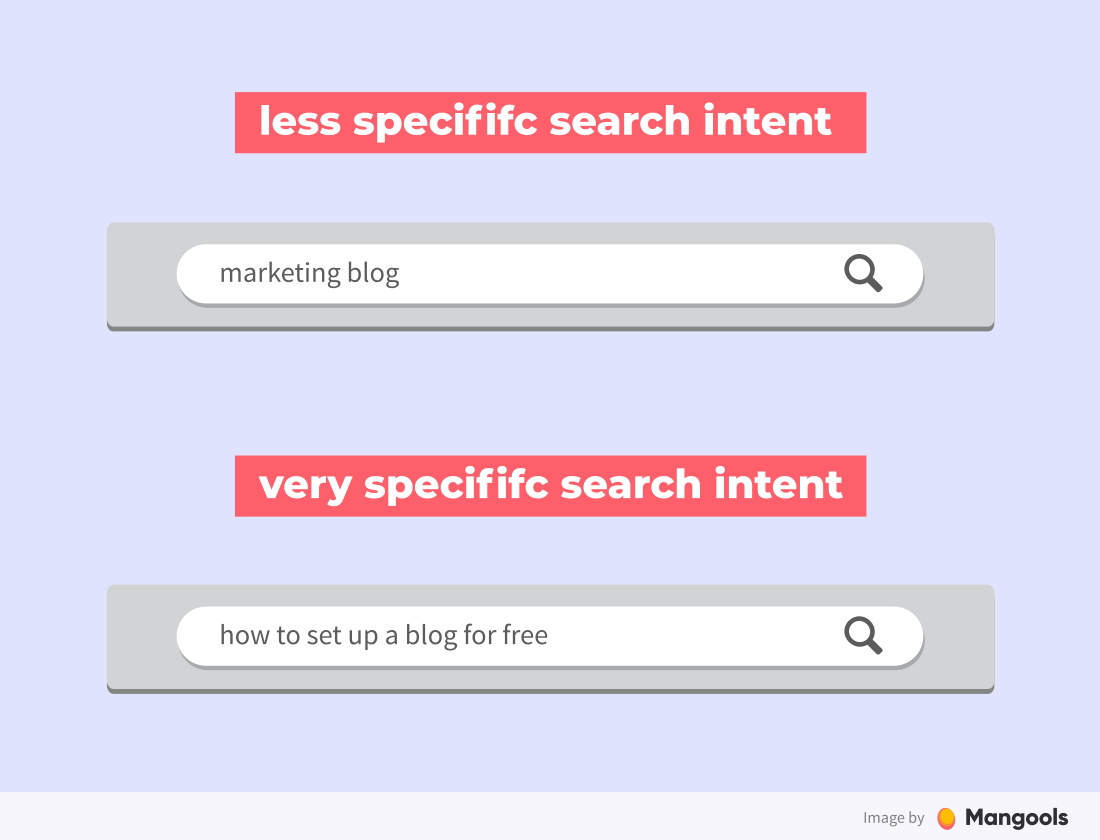
The latter, long-tail version has more drive. They want to do something – be that start a blog, purchase a domain, or build an email list. The short-tail term is likely just someone searching for very top-level marketing advice.
So, why is this important for your business?
The answer is simple. By targeting these long-tail phrases on your site, you’re attracting people who want to take action, whether that’s:
- purchasing a product
- signing up to an email list
- visiting your brick and mortar store
This is likely to boost your content marketing’s ROI – especially if you’re able to rank well for popular (and relevant) long-tail keywords.
How to do long-tail keyword research
Now we’re on the same page about what the term “long-tail keyword” is (and why it’s important to your business), it’s time to put the work in to find those you can target on your website.
Here’s a simple five-step guide to long-tail keyword research:
1. Find your base term(s)
Let’s start with a simple question: What term best describes your website?
Your answer should be related to your product/service offering, such as “sales software”, “Sales Coaching” or “CRM”. This is your base term. (Or terms; you might have a handful depending on how many features or services you offer.)
All of your long-tail keywords span from this base term.
For example: From the base term “CRM”, you could target the following long-tail variations:
- “best CRM for small businesses”
- “how to add contacts into a CRM”
- “HubSpot vs [(YOUR COMPANY)”
Unsure what your base term(s) should be?
Shoot a survey out to your existing customers in their purchase confirmation emails. Ask for one word that best describes you or the word they think of when they see your product/brand.
This is usually your base term – and how people who’ve completed a huge goal (purchasing from you) would describe you.
Remember: Your goal is to attract more people similar to those who already are your customers. Take their input on board.
2. Use Google’s Related Queries feature
Let’s be sure we’re not missing anything by going straight to the horses’ mouth: Google.
A suggestion box pops up when you begin typing a question into Google.
Add prefix/suffix to your base term, such as:
- What is (BASE TERM)
- How to (BASE TERM)
- Best (BASE TERM)
- (BASE TERM) for
- Why does (BASE TERM)
Then take a look at those suggestions. Make a note of the long-tail phrases your customers might be searching for:
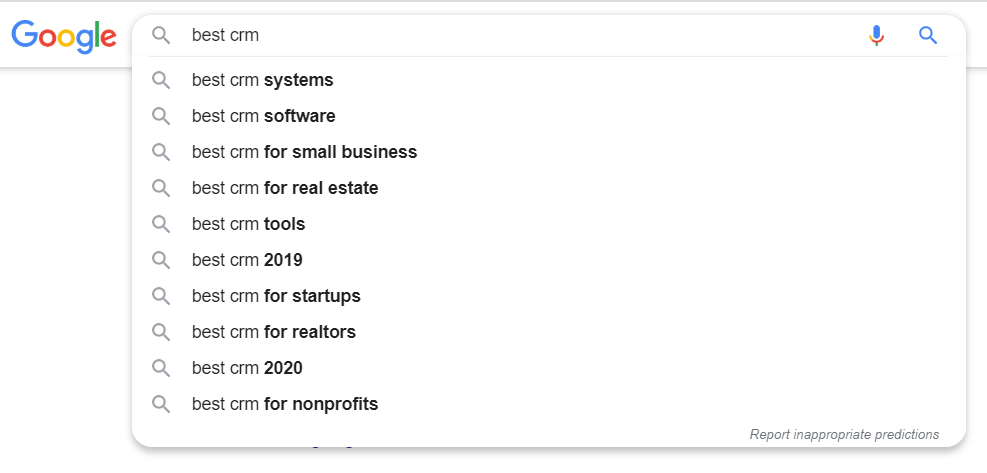
You can also find long-tail keywords in the People also ask box for that base term:
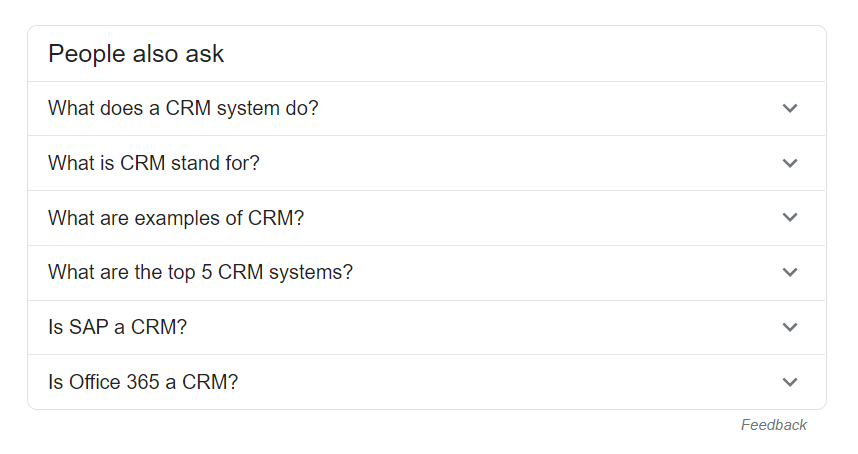
Another source of related queries on Google’s results page is the bottom panel with related searches:

Tip: If you click on any of the questions in the People also ask box, more new questions will appear.
Both of these methods show you what other questions/search terms people usually search before or after the SERP you’re viewing.
Think about whether you can add these to your target list.
3. Plug the base term into a long-tail keyword research tool
How do you go from those basic one-word phrases to a bunch of long-tail variations?
Head to our keyword finder tool – KWFinder and enter your base term. You’ll see a bunch of related keywords alongside important keyword information, like search volume and a list of competitors currently taking the top spots in a Google search result for that phrase.
Scroll through the list and tick any phrases that are:
- Relevant to your base term
- Likely to be searched by your target customer
Here’s what that looks like for the base term “CRM”:
Besides the main suggestions, you can use the “Autocomplete” or “Questions” tab to show more relevant long-tail keywords containing your seed keyword.
Google limits autocomplete to a maximum of 10, so you’ll need to play around with it to get a decent amount of suggestions. However, KWFinder shows them all in one list:
In the example above, you can see how the base term can be used to find new long-tail keyword opportunities by adding a prefix/suffix – we used the seed keyword “best crm for”.
Alternatively, you can find long-tail keywords using free keyword research tools. However, they only serve as keyword suggestion tools, you don’t get any metrics like search volume or keyword difficulty.
My personal favorite is AnswerThePublic. Follow the same process and plug your base term into the tool. You’ll see a list of popular questions that people search for, containing your base term:
4. Dig through your site’s analytics
You don’t have to start targeting long-tail keywords with a new piece of content from scratch.
Find what you’re already ranking for, and the terms people are searching to find your website, using the performance report inside Google Search Console.
Head to Performance > Google Results, then organize your rankings by position.
Click through until you’re viewing keywords you’re ranking on page two (and beyond) for:
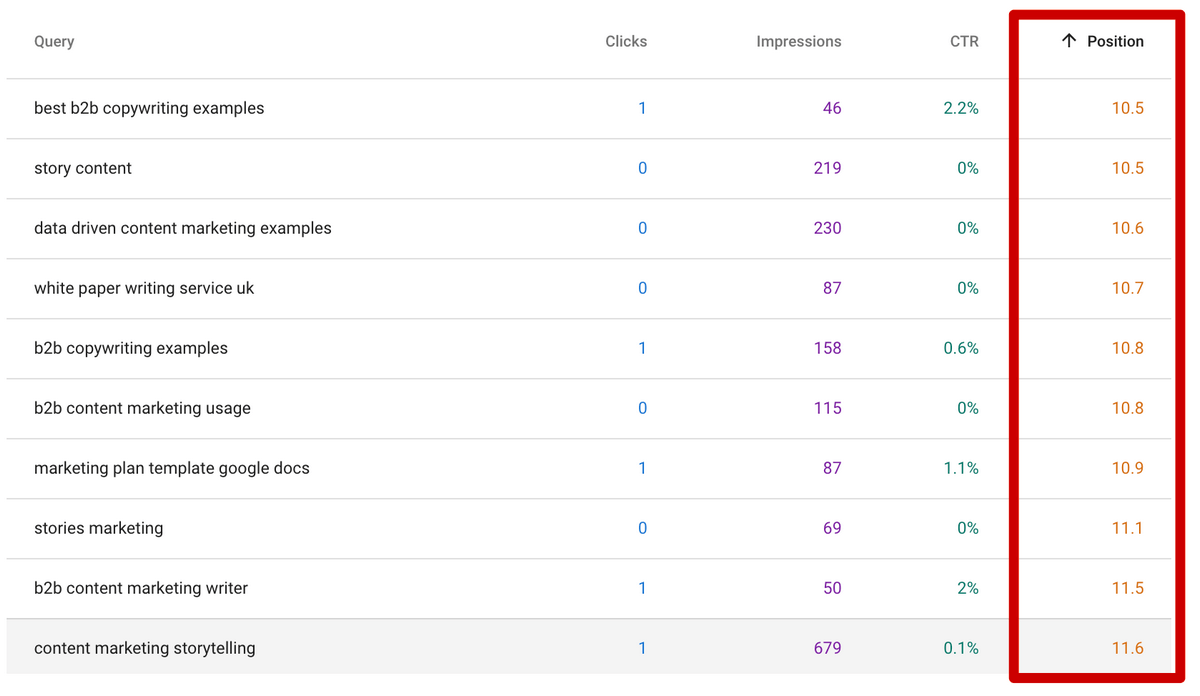
Granted, you’re already ranking for those long-tail terms. But import them back into your long-tail keyword research tool and see what keywords would be worth pursuing (more on that in the next chapter).
Here’s what that looks like for the keywords from the previous screenshot:

5. Look for long-tail terms in customer feedback
Customer feedback is invaluable to businesses.
Ask yourself: What terms or phrases do your customers ask during the sales process, or after they become a customer? We want more people like them to arrive on our website, solve their problems, and give them a spot on our purchase list.
Tip: Put together a quick survey that you can include in automatic email confirmations.
Ask questions like:
- What were you looking for when you decided to search for a product like ours?
- Which terms did you search for to find us?
- Which piece of content did you read before purchasing?
You might find answers like “I searched for ‘best CRM for small businesses’”, or the fact they read your comparison guide before becoming a customer.
Whatever you find, plug those terms into a keyword research tool. You might find similar, related phrases you can target to attract more potential customers to your website.
What makes a “good” long-tail keyword?
There are billions of long-tail keywords you could pick from, as you’ll see during the keyword research process.
How do you know which you should hone in on; those with the most value?
Generally, a “good” long-tail keyword considers these three things:
- Popularity (search volume)
- Keyword difficulty
- Relevance
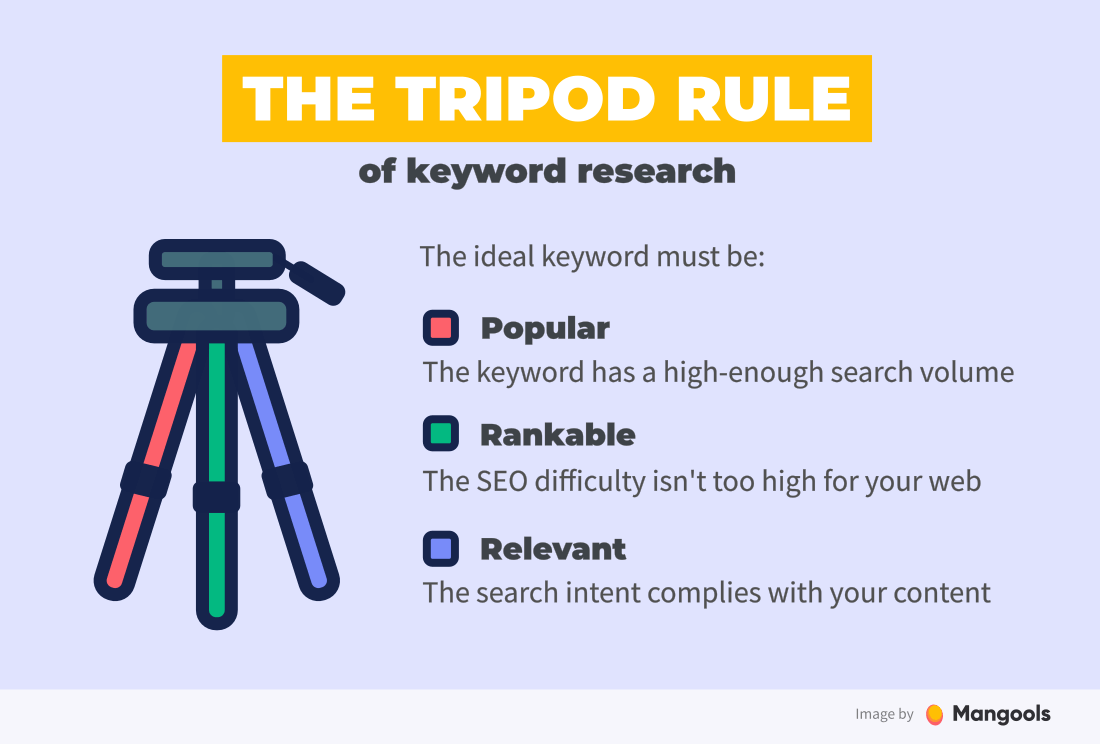
1. Search volume
The search volume of a keyword tells you how many people search for the phrase each month. It’s shown in most long-tail keyword research tools (including KWFinder.)
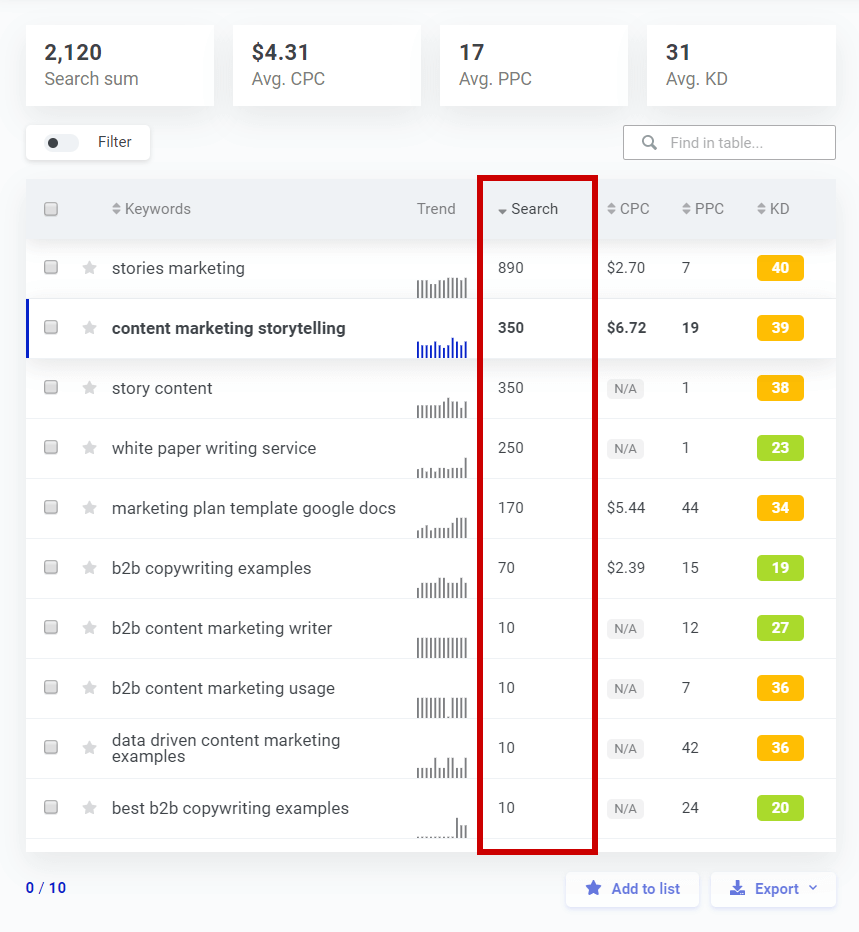
The tricky part?
A “good” search volume depends on the industry you’re in. (For example: 3,900 people search for “b2b marketing strategies” versus 450k for “how to lose weight”.)
Generally, for keywords with a search volume of…
- <50: Avoid or group together (unless you’re trying the Keyword Golden Ratio technique)
- 50-250: Group similar terms together
- 250+: Use as a standalone focus keyword
Let’s put that into practice and say you’ve got these keywords with search volumes:
- “Blogging tips for beginners” (10): Merge with similar phrases like “how to start a blog” and “blogging advice”.
- “Grow your email list” (180): Merge with similar phrases like “email list builder” or “ways to grow your email list”.
- “How to start a blog” (116,000): Create a standalone guide to target this long-tail keyword
2. Keyword difficulty
Keyword difficulty is an SEO metric that describes how hard it will be to rank for a specific keyword.
Each phrase has a score out of 100, with the low end indicating it’s easy to rank for it. Keywords on the higher end of the scale indicate you’ll need to put more effort into SEO optimization to rank on page one for.
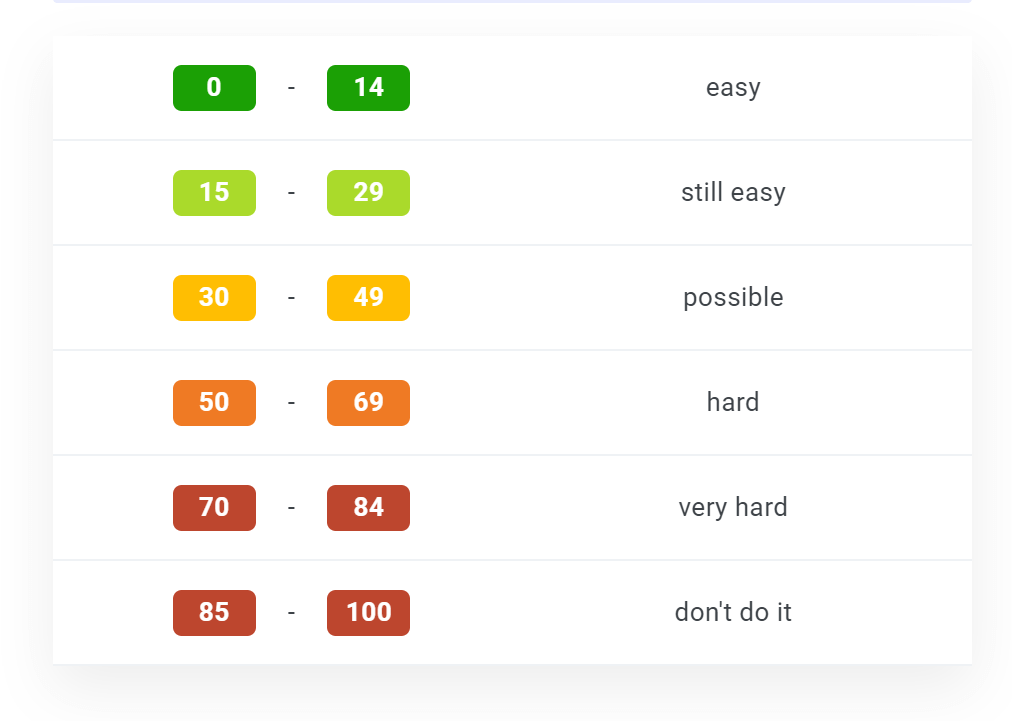
So, what keyword difficulty score should you aim for?
Just like any SEO answer, the truth is: It depends.
Your approach to this depends on the size and authority of your website.
Smaller sites without much authority should start small with low keyword difficulty. It’s low-hanging fruit – there aren’t many other websites trying to rank for the term, so it should be relatively easy.
Large sites with SEO weight can start tackling the phrases with a medium/high difficulty score. They’ve already built some trust with Google, and they’re able to outrank some of the competition, so it’s more likely they’ll rank well for the term…
3. Relevance
If you don’t offer a product/service that someone searching a long-tail keyword would be interested in, don’t pick it.
Sounds obvious, right? But it can be harder than it sounds.
For example: If you’re a car mechanic, “why isn’t my AC working” is a more relevant long-tail keyword than “how to become a car mechanic” – even though the latter is an exact-match term.
The first is something a potential customer would search for. The latter is likely being searched by a student who doesn’t need a service the mechanic offers, so it doesn’t make sense to target it on your website.
You’re able to find this by taking a look at what Google already thinks a keyword means, and the companies behind each spot.
Search your long-tail keyword and analyze the top results for it.
Let’s look at that using the “why isn’t my AC working” long-tail keyword example:

The three organic results are from home service companies that offer this as a service.
Plus, we can see that two of the high-ranking results are question-based; the other is a listicle. Consider following the same format with content. (Those formats are ranking well for a reason.)
Now, let’s take a look at how to work with the search intent…
How to use your long-tail keywords
You’ve whittled down your list of long-tail keywords, and are confident that your ideal visitors are searching for them.
The next step is using them on your website. This tells Google that you’re talking about something related to that long-tail keyword, increasing your chances of ranking well for it.
Tip: Never try to use the keywords artificially in your content only to rank for them. Google is clever enough to find out. Instead of keyword stuffing, write the best content on the topic and write naturally.
Use the focus keyword wisely in the main elements (like title, heading, paragraphs, alt text) but don’t forget about the common sense. If you focus on a super long-tail keyword like “the best content management system for small businesses” it would be unnatural to use it 5x in a short blog post.
We talk about the focus keyword optimization in our guide to on-page SEO.
Think about search intent
The biggest mistake when you’re targeting long-tail keywords is to assume a blog post is the answer. All you need to do is pick your term, write a 1,000-word post and publish it to your blog, right?
Not necessarily.
The absolute first step in targeting your long-tail keywords is to decide on the type of content you’ll use, based on the intent behind the phrase.
Search intent describes the motivation of the person searching for the term. It can tell you how to package your content, and is usually broken into four categories – know, go, do, and buy – as explained by Google:
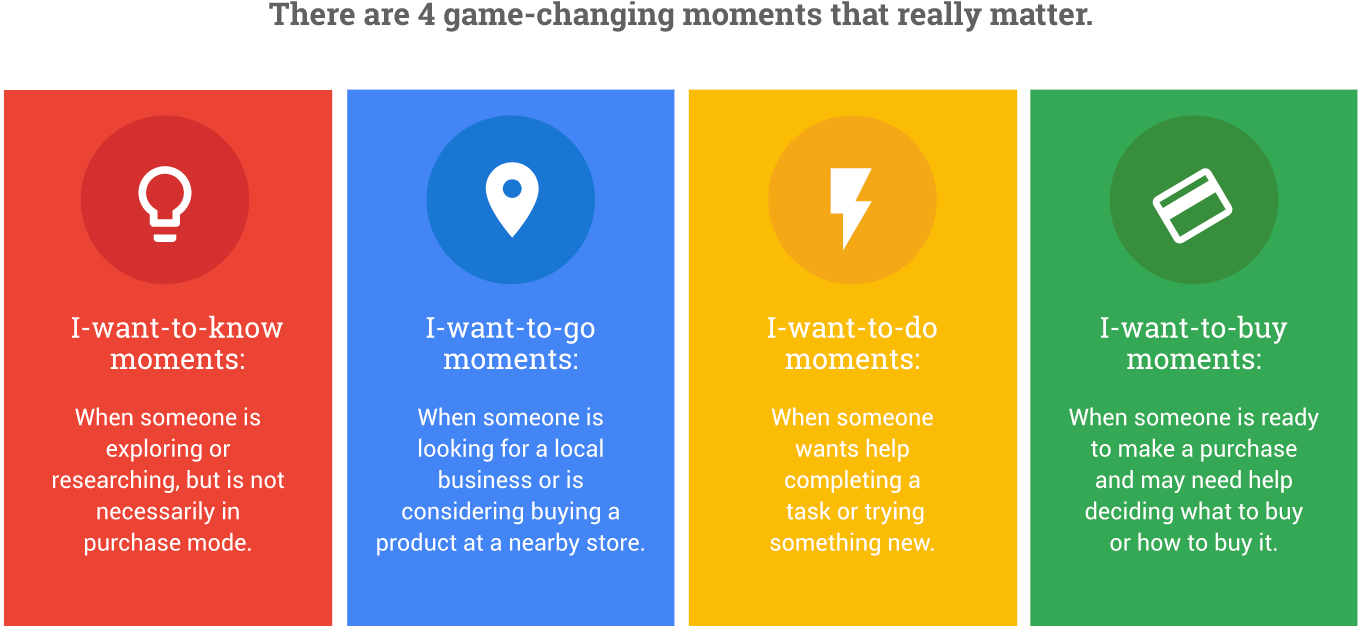
Here are some long-tail keyword examples alongside the search intent, and the content you might create for each:
1. I want to buy
Example: “men’s black vans sneakers discount”
Long-tail keywords that are specific to a product or service, like the example above, show a searcher’s intention to buy.
They usually consist of a (PRODUCT/SERVICE) +
- buy
- price
- discount
- sale
They’re probably not looking for a blog post that collates the best shows, so in this case, it’d be best to target the phrase on your product page. This is where you want people searching this term to end up, and likely the best way to give them what they’re looking for.
2. I want to go
Example: “best Chinese food in LA”
Location-based long-tail keywords show an intention to go somewhere. Again, the ideal place for these keywords might not always be a blog post.
For example: If you think you offer the best Chinese food in LA, add this to your homepage or title tag.
But what if you’re a food blogger without a physical restaurant in LA for people to visit? In this case, you could create a round-up of best restaurants to rank for that term.
The searcher wants to go somewhere; they’re looking for information that gets them there. Tie this in with the product or service you offer.
3. I want to know
Example: “what’s the best CRM for small businesses”
The person searching for this keyword wants to find the best solution for their problem. They want to compare different CRM software, so a comparison guide is likely to help them get what they need to know.
Put together a comparison post that compares your CRM to other popular options. What features do you have that they don’t? How does your pricing compare? How many team members are allowed an account?
These are all questions the searcher would likely be interested in when searching for “what’s the best CRM for small businesses.” If you can answer all of them in one comprehensive guide, there’s no reason why you couldn’t impress Google and potential customers.
4. I want to do
Example: “how to train for a hike”
This person – or anyone searching for “how to…” – wants advice on doing something.
They’re high on the sales funnel and don’t necessarily have an intention to purchase a product even if you’re recommending one in the content.
So, you could package your advice in an easy-to-digest piece of content, such as a:
- detailed step-by-step guide
- video tutorial
Group similar long-tail terms keywords
What happens if you’ve got a list of long-tail keywords that all have the same intent, similar search volumes, and ask the same question?
Creating a single post for each long-tail keyword wouldn’t make any sense.
Let’s put that into practice. The long-tail keywords “how to set up a blog”, “how do I start my own blog” and “how to create a free blog” all have a similar intent.

If you were to target them with three separate blog posts, you’d likely use all three terms in each piece. Because you’ve got three pages essentially discussing the same topic, Google wouldn’t know which to rank highly – so all three are pushed down.
However, if all three terms were bundled together in a single blog post, Google knows exactly what they should rank you for.
Their LSI algorithm works by finding relevant terms to the page’s main keyword. If they can find multiple related long-tail keywords in a single post, it increases the chances of ranking for more long-tail phrases.
Improve keyword rankings on already-published pages
Remember how earlier, we mentioned you don’t need to start from scratch when doing keyword research? You can dig through your Google Search Console data to see what you’re already ranking on page two (and beyond) for.
A similar concept applies to content creation; you don’t need to create a brand new blog post for each long-tail keyword you’ve already got on your list… Especially if you’re already ranking for it.
Here’s what that looks like for Mangools’ SEO guide. It covers the basic terms like “what is SEO” but has a separate section targeting the long-tail keyword “how can I learn SEO”:
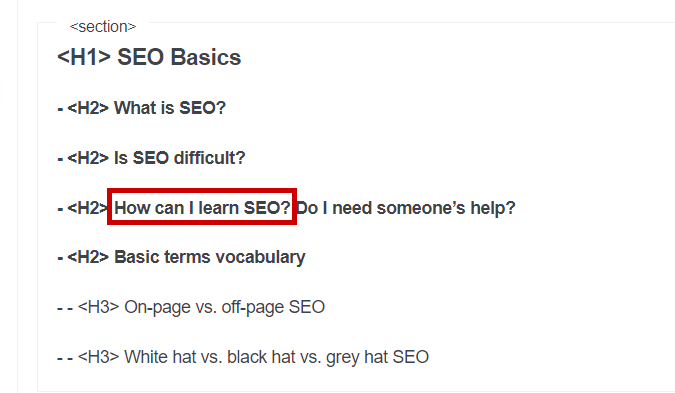
And here’s the SERP for that keyword:
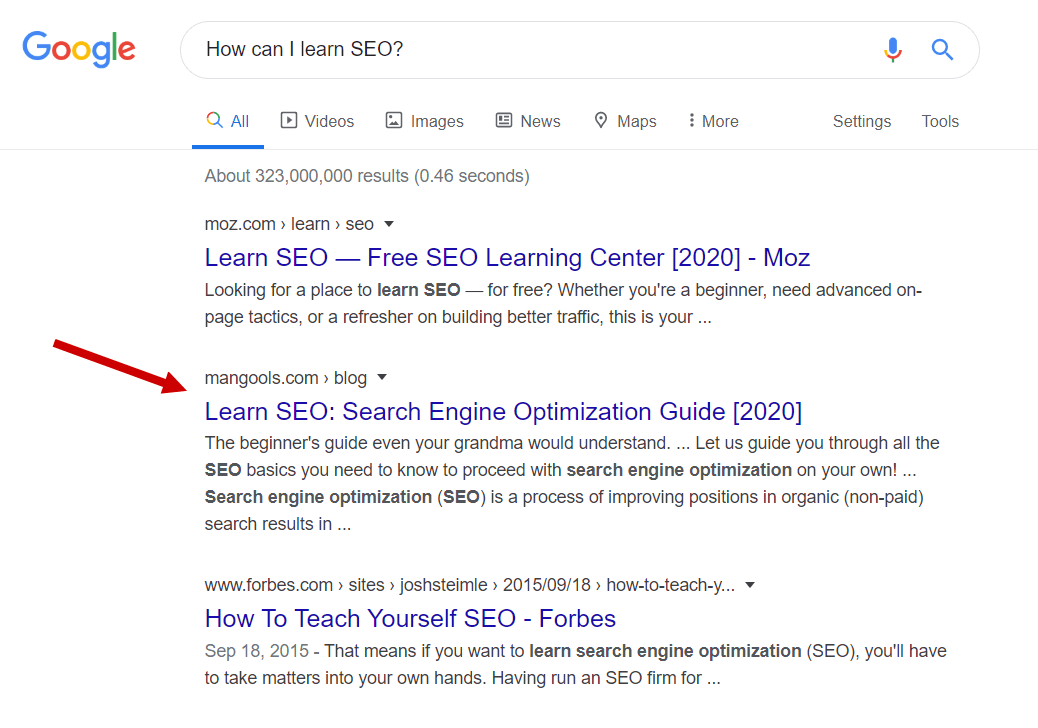
So, instead of creating a brand new blog post, edit the page’s content to reference the new long-tail term. This can be as simple as adding a short section answering the question.
But because Google knows you’re answering that on a page about a relevant topic, there’s a high chance they’ll bump up your rankings for that phrase.
Conclusion
There are hundreds of long-tail keywords your audience is searching for.
Follow the steps we’ve shared in this guide to find them, then start targeting them on your website to tell Google (and your customers) that your information is valuable to anyone searching for them.
You’ll soon start to see steady growth in organic traffic.





